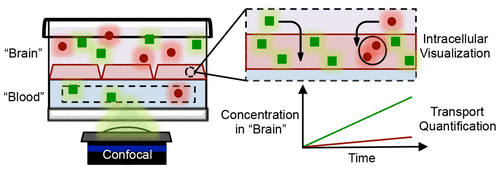当前位置:
X-MOL 学术
›
Mol. Pharmaceutics
›
论文详情
Our official English website, www.x-mol.net, welcomes your
feedback! (Note: you will need to create a separate account there.)
Efflux Pump Substrates Shuttled to Cytosolic or Vesicular Compartments Exhibit Different Permeability in a Quantitative Human Blood–Brain Barrier Model
Molecular Pharmaceutics ( IF 4.5 ) Pub Date : 2018-09-13 00:00:00 , DOI: 10.1021/acs.molpharmaceut.8b00662 John S. Ruano-Salguero 1 , Kelvin H. Lee 1
Molecular Pharmaceutics ( IF 4.5 ) Pub Date : 2018-09-13 00:00:00 , DOI: 10.1021/acs.molpharmaceut.8b00662 John S. Ruano-Salguero 1 , Kelvin H. Lee 1
Affiliation

|
Representative in vitro blood–brain barrier (BBB) models can support the development of strategies to efficiently deliver therapeutic drugs to the brain by aiding the characterization of their internalization, trafficking, and subsequent transport across the BBB. A collagen type I (COL1) hydrogel-based in vitro BBB model was developed to enable the simultaneous characterization of drug transport and intracellular processing using confocal microscopy, in a way that traditional insert-based in vitro BBB models cannot. Human induced pluripotent stem cells (hiPSCs) were differentiated into cells that exhibited a BBB-like phenotype on COL1 hydrogels, which included the expression of key BBB-specific proteins and low permeability of representative small and large molecule therapeutics. Furthermore, the BBB phenotype observed on the COL1 hydrogel was similar to that previously reported on porous inserts. The intracellular visualization of two small molecule efflux pump substrates within the hiPSC-derived BBB-like cells demonstrated a difference in cytosolic and vesicular accumulation, which complemented permeability measurements demonstrating a difference in transport rate. The easy-to-construct COL1-based hiPSC-derived BBB model presented here is the first in vitro two-dimensional BBB experimental system that enables the simultaneous quantification of cellular permeability and visualization of intracellular processes by utilizing confocal microscopy, which can provide insights regarding the relationship between transport and intracellular trafficking of therapeutic drugs.
中文翻译:

穿梭到细胞或囊泡隔间的外排泵基质在人类血脑屏障定量模型中表现出不同的渗透性
代表性的体外血脑屏障(BBB)模型可以通过辅助表征其内在化,运输和随后跨BBB的运输来支持将治疗药物有效递送至大脑的策略的开发。开发了一种基于I型胶原(COL1)的水凝胶体外BBB模型,能够使用共聚焦显微镜对传统的基于插入物的体外药物转运和细胞内加工进行同时表征BBB模型不能。人类诱导的多能干细胞(hiPSC)分化为在COL1水凝胶上表现出BBB样表型的细胞,其中包括关键BBB特异性蛋白的表达和代表性小分子和大分子治疗剂的低渗透性。此外,在COL1水凝胶上观察到的BBB表型与先前在多孔插入物上报道的相似。hiPSC衍生的BBB样细胞内两个小分子外排泵底物的细胞内可视化显示了胞浆和囊泡积聚的差异,这补充了通透性测量结果,显示了转运速率的差异。该易于构造基于COL1-hiPSC来源BBB模型这里介绍的是第一次在体外 二维BBB实验系统,可通过共聚焦显微镜同时量化细胞通透性和细胞内过程的可视化,这可以提供有关治疗药物的运输与细胞内运输之间关系的见解。
更新日期:2018-09-13
中文翻译:

穿梭到细胞或囊泡隔间的外排泵基质在人类血脑屏障定量模型中表现出不同的渗透性
代表性的体外血脑屏障(BBB)模型可以通过辅助表征其内在化,运输和随后跨BBB的运输来支持将治疗药物有效递送至大脑的策略的开发。开发了一种基于I型胶原(COL1)的水凝胶体外BBB模型,能够使用共聚焦显微镜对传统的基于插入物的体外药物转运和细胞内加工进行同时表征BBB模型不能。人类诱导的多能干细胞(hiPSC)分化为在COL1水凝胶上表现出BBB样表型的细胞,其中包括关键BBB特异性蛋白的表达和代表性小分子和大分子治疗剂的低渗透性。此外,在COL1水凝胶上观察到的BBB表型与先前在多孔插入物上报道的相似。hiPSC衍生的BBB样细胞内两个小分子外排泵底物的细胞内可视化显示了胞浆和囊泡积聚的差异,这补充了通透性测量结果,显示了转运速率的差异。该易于构造基于COL1-hiPSC来源BBB模型这里介绍的是第一次在体外 二维BBB实验系统,可通过共聚焦显微镜同时量化细胞通透性和细胞内过程的可视化,这可以提供有关治疗药物的运输与细胞内运输之间关系的见解。









































 京公网安备 11010802027423号
京公网安备 11010802027423号